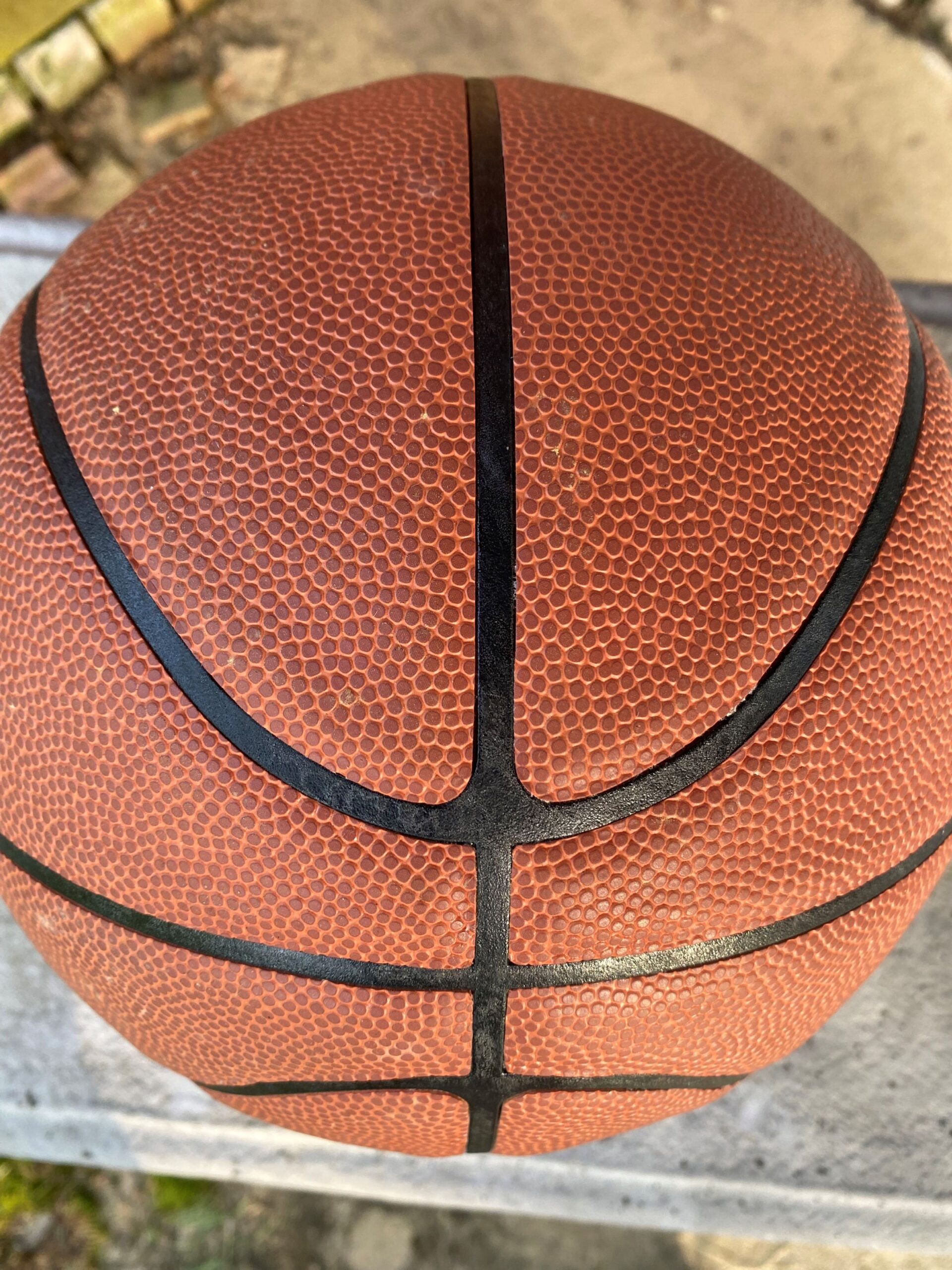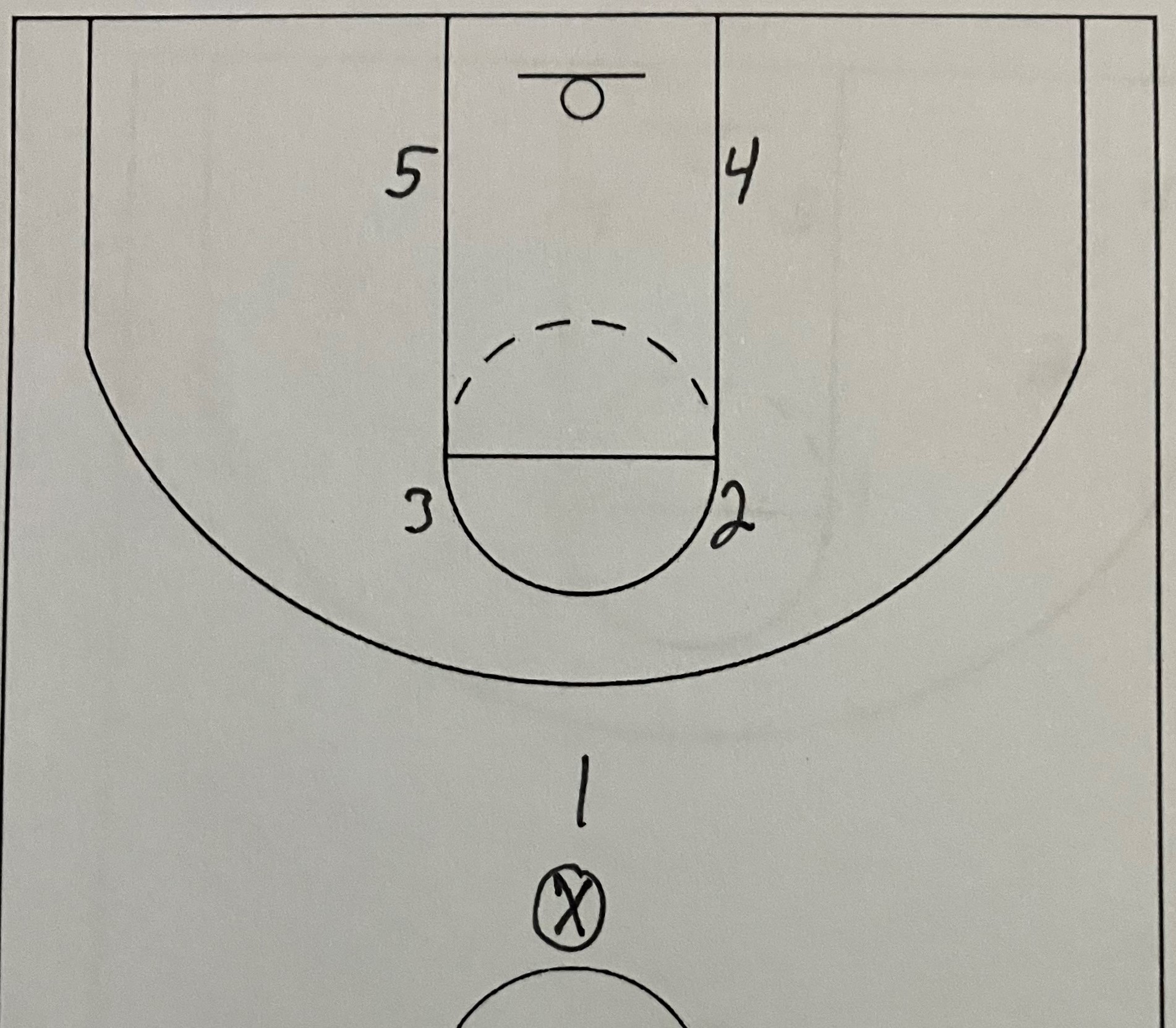What is I Defense?
The I formation defense or I for short is the last combination defense. There is the box-1 and triangle-2 defenses which are much more common. The “I” is 3 defenders playing man-to-man and the other 2 defenders playing in what I call a tandem defense. Anybody who has ever done the 3 on 2 drill will immediately see the “I” as the 2 zone defenders playing in a game just like what you would see 2 defenders playing in the 3 on 2 drill.
The 2 zone defenders are playing with one at the foul line and the 2nd defender playing in front of the basket. These 2 defenders are playing in tandem with each other. When one player goes out to guard the ball the other player goes to the basket. As the ball is passed the 2 players will rotate who takes the ball and who takes the basket. This is the very simple explanation of the “I” defense.
This defense is used when an opponent has 3 good players and the other 2 are not offensive threats. This could mean that the other 2 players on the opposing team may be defensive players or good rebounders, but they do not look to score very often. In high school, there are a lot of teams who have a player or two that plays a lot but does not have a scoring role. If an opponent has two of those types of players then the “I” defense can be an option for a defense to play against that opponent.
Advantages of the “I” Defense
1) All focus on top 3 offensive players
Most of the time if you can stop or limit the opponent’s best 3 offensive players, then you are going to win the game. This “I” formation defense takes that line of thinking and goes to the extreme. The defense is guarding the 3 best players man-to-man and leaving the other 2 offensive players free to do what they want. The non-man defenders are playing in an I formation with one player at the foul line for help and the other around the basket for help as well. These two players should always be in a position to help any of the 3 man defenders. This puts all focus on those 3 offensive players which should help to keep them from getting their traditional points per game average. If a team can keep those 3 players under their points average, then the defense should have a good chance of winning the game.
2) Can double team and help on 3 best players
Very similar to the first advantage I listed is being able to double team the 3 best players. By committing to this defense, the team has already decided to give the opponent’s 2 other players open shots. The defense can again take the openness to the extreme by having the two “I” zone players looking to constantly double team the 3 players being guarded man-to-man. This puts a lot of effort on those two players because they are going to be covering a lot of the floor, but it does force the offense to use those 2 other players more consistently. And if the defense wants the ball into those 2 players’ hands maybe due to bad decision making, then this could be the perfect scenario for the defense. Lastly, the double teams could cause some turnovers by the offense.
3) Can confuse the offense
The “I” defense is not ran very often. Many people do not know what is happening when they see it. This unknown can confuse the opponent.
I was watching a game and one team was a heavy underdog against the other. The underdog used the “I” defense. The first possession the underdog ran the “I”, the favorite called a man offense. They started the offense then stopped re-centered the ball and called a zone offense. They started the zone offense and then stopped and re-centered the ball back to half-court. And during the actual game, I saw the players and coaches talking back and forth about whether to run a man or zone offense. The favorite did not have a clue as to how to play against the defense. They did not know what kind of defense was even being ran against them. They were completely confused.
The underdog led until about 3 minutes left to play in the game when one of the other 2 offensive players made about 3 baskets in a row at the foul line to give the favorite the lead. The favorite was able to hold the lead and win by about 5 or 6 points. On paper, the favorite was about 20 points better than the underdog but the underdog led most of the game and almost pulled a major upset. The “I” defense might work just on the opponent not having a clue as to what to do to play against the combination of man and zone.
Disadvantages of the “I” Defense
1) All focus on top 3 offensive players
This can be an advantage, but it also can be the disadvantage which makes the defense unplayable. Like I just said if one of the other two players start scoring, then the defense is not going to work. The “I” defense is dependent on those other two offensive players not scoring. Once one or both of those players start scoring then the defense must be changed.
2) Rebounding
Since the “I” defense is leaving 2 players free to move, those 2 players should have some good chances to get offensive rebounds. If those 2 players can get rebounds and keep possessions alive with a 2nd or 3rd chance, then the defense is going to struggle. Unless the defense has a rebounding machine as the bottom of the “I”, the 2 zone defenders must rebound together and help to end the possession with the ball.
Realistically, the defense should have one of the better rebounding guards as the top of the “I”. The top zone player can turn a possible disadvantage into an advantage. If the top zone player can rebound out of the zone, they can take a worry for the other players and solve the rebounding issue. The defensive players cannot start to leak out looking for an easy basket because the defense is already leaving 2 offensive players free to crash without a direct box out.
3) Leaves other 2 players open and free to move
The 2 non guarded players on offense will be completely free to move and go where they wish. This only presents a problem if they start to score. However, this gives the offense a chance to put in 2 players knowing they will have time and space on offense. If the offense wants, they can put in a shooter and put them in a spot on the wing knowing when the ball is passed to them, it should be a wide open three.
The offense can put in a good rebounder and have them stay on the block to try and get as many offensive rebounds as possible. The offense has the ability to play players that may not play often because they are not good with pressure. But with the “I” defense, this is no longer a concern.
The defense putting all the focus on just 3 offensive players leaves the ability of the opponent to create a scenario on offense they wish to have. The other 2 offensive players can fill any role in any spot when they are on offense. This is giving the offense the freedom to do as they wish. The defense is doing nothing to prevent or change the decision. This freedom when done correctly puts the defense into bad positions. The advantage of the defense may be the offense not understanding their ability to choose or choosing the wrong thing to counter the “I” defense.
Positions of the “I” Defense
There are two ways to play the “I” with the 2 zone players. The first way is to basically cut the court right at the foul line. The top player guards the ball for anything above the foul line and the bottom guards the ball for anything below. This keeps everything very simple. If the ball is below the foul line, then the bottom player takes the ball and the top player drops to the basket. If the ball is above the foul line, then the top player guards the ball and the bottom player stays in front of the basket.
This is a way to keep everything simple with the least amount of rotating as possible. However, the drawback is the 2 zone players could be running around back and forth quite a bit if the offense can swing the ball back and forth in the half court.
The 2nd way is to have the 2 zone players work similar to a 3 on 2 drill. The top player takes the ball. On the pass the bottom player steps out to the ball and the top player drops. On the 2nd pass the top player takes the ball again and the bottom player drops again. And the two zone players keep rotating back and forth with every pass. This is how the 3 on 2 drill takes place.
The problem with having those two players rotate is twofold. First both players must be able to guard the outside and rebound on the inside. If the 2 zone players are a guard and a big, then the 1st way would be best. However, if both players are forwards, then rotating back and forth would be fine. The second issue is the ability of the 2 zone players to keep switching back and forth without getting confused. Sometimes in the 3 on 2 drill both defenders will guard the ball which leads to an easy layup. The same problem could occur here in a game and lead to the opponent getting that easy layup.
Which one should a team use? That is up to the coaches or players. If the “I” defense is being put in quickly then option 1 without the rotation would be best. If this is being used against a conference opponent and is slowly being practiced way ahead of time, then those two players might have enough time to work on rotating back and forth to get comfortable. Either option can work. It really depends on all the variables that surround the decision to play the “I”.
Trapping in the “I” Defense
The only trapping for the “I” defense would be with one of the zone players trapping with one of the man defenders. However, even this trapping should be very limited. The defense should maybe pick only one of the three to trap or trap in a certain situation. The zone players should be there to help and trap when the ball comes at them, but I would not recommend chasing a trap with the 2 zone players.
Personnel Needed for the “I” Defense
There is no personnel required to run this defense. Of course, the better 3 man to man defenders a team has, the better the “I” is going to work. If the 3 man to man defenders can not guard their man then the 2 zone players are going to be in constant help which leaves even more floor space open then the defense is already giving up. The hope is that the 3 man to man defenders can guard their man without help and the help is there to give the offensive players more to worry about.
Keys to the “I” Defense
1) Limit the 3 best offensive players
The entire “I” defense is to try and keep the 3 best offensive players scoring below their points per game average. As a defense, you want those 3 players to score below their average. If a defense can keep the offense’s best players to score less than normal, then the defense gives their team a good chance to win the game. By reducing the points per game average of the 3 best players, the defense does not have to score as much on offense. The less points a team has to score, the more likely they are to win a game.
2) Communicate
This is not a normal defense, so most teams are not going to have a bunch of practice time playing this defense before using it in a game. The best way to help a defense succeed in a game is to overcommunicate with each other. The better communication a defense has, the better the defense plays. This holds true for the “I” defense as well. The 2 zone players should be constantly talking. The 2 zone players should be talking about player movement, screens, where the ball is at, and when there is a shot taken. All this information makes the 3 defenders guarding man have an easier time because they know when and if a screen is coming or when the ball is close to them. The more information each defender has, the more likely they are going to be in the best positions to defend the offense.
3) Have a Lead
This is not a defense to use when behind because the offense can just pass the ball back and forth between the 2 players not being guarded. This is assuming there is not a shot clock. If the defense has the lead, then the offense will have to score. If they have to score, then the offense must shoot the ball. This makes the offense play against the defense rather than just holding the ball waiting for the defense to change what they are doing. The defense having a lead forces the offense to play and not just waste time until the defense changes.
Youth Basketball
This is such a niche defense that most high school teams do not even think about it being possible much less running it. At the youth level, this defense should not be used. It is a very special defense and very limited in its usage. It is a win at all cost type of defense. There is not a win at all cost type of situation in youth basketball to use this defense.
Conclusion
It is the last of the combination defenses after the box and 1 and triangle and 2. It is used far less than those 2 other combination defenses. It can work and has worked. It can cause confusion among the offense. It does tend to work until one of the other 2 offensive players starts to score. Until this happens the defense can work. Once the 4th or 5th offensive player starts to score or the offense is able to get a lead, then the defense can stay in the “I”.
The “I” defense is not something that a team will use every year but it is something to keep in the back of the mind of a coach to pull out at just the exact right moment during their career. That right moment may never come. But if it does and the “I” defense is used, a big underdog could surprise the favorite with the defense and pull a major upset.



3 thoughts on “I Formation (3-man; 2 zone) Defense Guide”